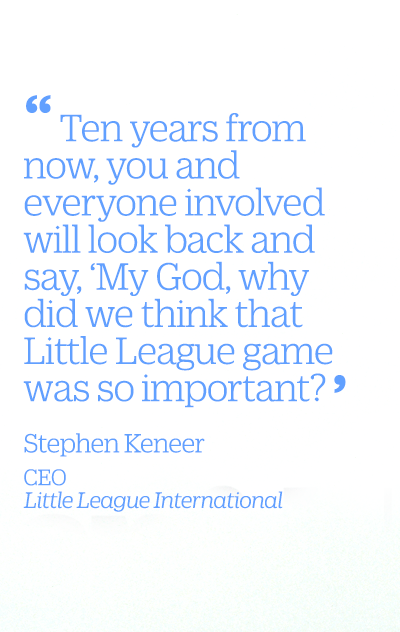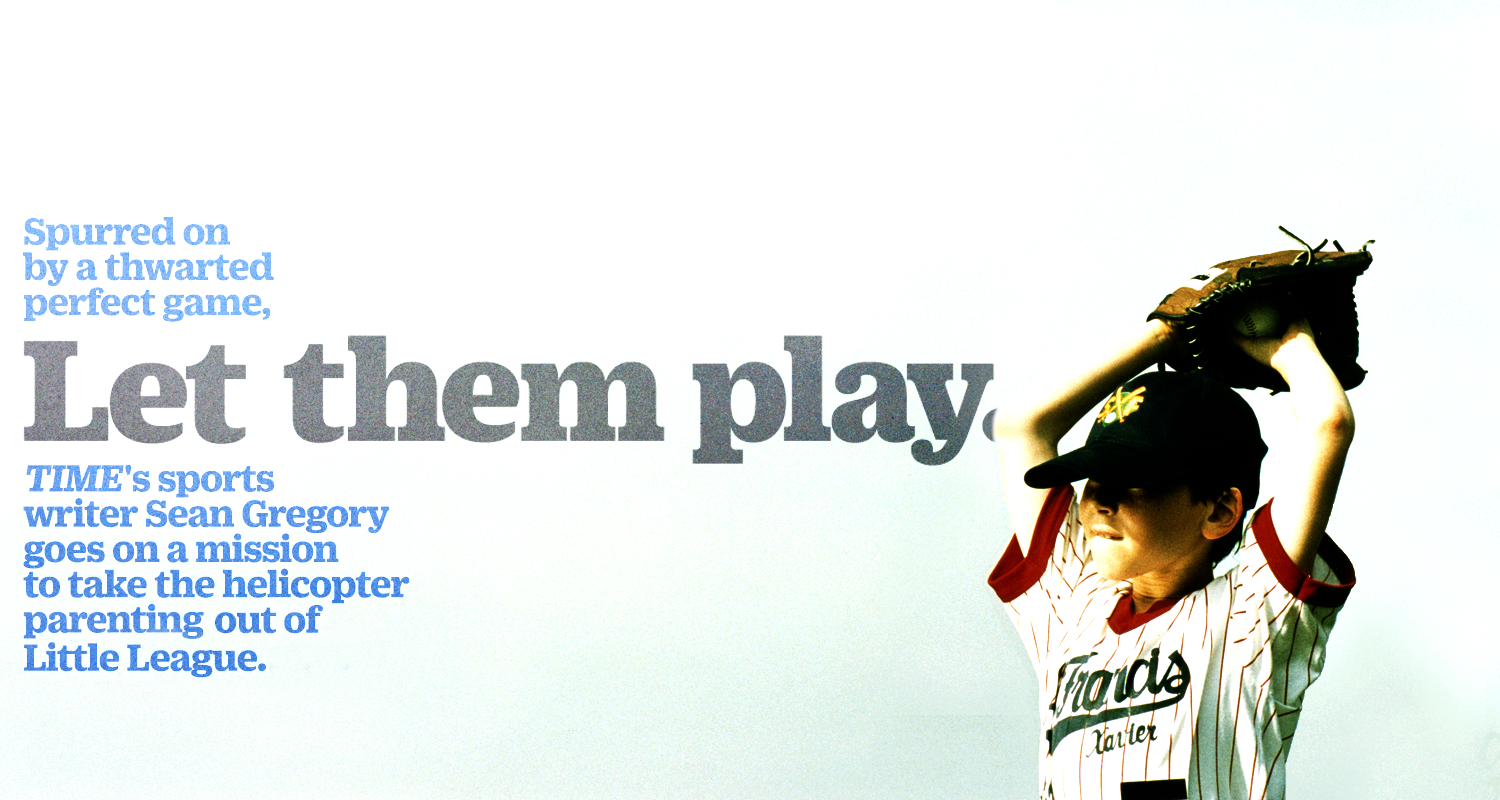Adrenaline swept through my body. My heart pounded, as if I were 10 again, and my favorite team was a strike away from winning the World Series. Is this really happening? For this team? For this kid?
On a glorious spring evening back in May, my son’s Little League squad, the Local 40 Ironworkers Mets, had just taken a two-run lead against their archrival, the Frankie’s Tavern Yankees, in the bottom of the fifth inning. From the first-base coach’s box, I was getting way too invested in the outcome of this game. But could you blame me? One of our kids just smacked an inside-the-park home run. And the craziest thing was happening. Our best pitcher, Minecraft-enthusiast T.J. Hartey, had retired every single batter he had faced through the first five innings. Since Little League games go six innings, T.J.—who’s 10–was now just three outs away from accomplishing that rarest of baseball feats: a perfect game.
These Mets—not unlike the more famous ones—weren’t supposed to be flirting with baseball immortality, making T.J.’s performance all the more thrilling. They were in last place, and throughout the season the players hadn’t exactly put on any fielding clinics. But tonight, the gloves stayed down to snatch ground balls; the throws to first base hit the target, instead of sailing wide, wide, wide right. And it’s almost impossible for kids T.J.’s age to not walk—or plunk—a batter every inning or two. But tonight, he coolly tossed strike after strike, the focus etched all over his freckled face.
As T.J. pitched his third, fourth, fifth perfect innings, parents got caught up in the moment. We observed baseball tradition: you don’t mention that a pitcher is perfect, lest you jinx him. A few parents gave T.J.’s mom, Jackie, knowing smiles while she stood behind the fence. Others raised eyebrows at her. She just grinned back. After the fourth inning, I sauntered over to the head coach. “You know T.J.’s perfect, right?” I asked him. Being a good at this job, he told me to shut up.

Why get so excited about Little League? I’d never seen a perfect game, or no-hitter, in person. This was even better than sitting in a stadium, watching a million-dollar pitcher reach a milestone. I got to pat this pitcher on the back myself between innings. These kids—and my kid—would have a special memory if T.J. could pull this off. Plus, if anyone deserved something awesome, it was T.J. He’s the kid who puts his arm around his teammates after they make an error. He’s the one my son looks up to more than any other.
So yeah, I was pulling for this pretty hard. And after we took a two-run lead on a home run—we had barely hit a ball out of the infield all year—the ending seemed inevitable. This was just our night. The last-place Mets would achieve perfection.
But then T.J. had to leave the game.
According to Little League rules, if you’re 10, you can’t throw more than 75 pitches in a single game. T.J. had hit his limit, so he couldn’t finish off the outing of a lifetime. Sure, we held on to win 2-1. But there would be no perfect game, no no-hitter, no pileup of happy bodies on the mound, no extraordinary moment for T.J. or his teammates, all due to a rule from on high. T.J. wasn’t tired. “I could have pitched all day and night,” he said later. I believe him. I felt T.J., and our kids, were robbed.
It got me to thinking: How about a perfect-game exemption to the pitch count rule? Let a kid go to 90, or maybe 100, if he’s rolling: if the pitcher gives up a hit or walk, get him out of the game. Kids get so few chances to do anything extraordinary. Why take the chance of a real accomplishment out of a child’s hand?
T.J.’s parents agreed. They’re by no means bitter about what happened that night. But they’re understandably disappointed, and would like to see some compromise going forward. “Baseball is about those wonderful, unexpected moments,” says his dad Tom Hartey, a financial data specialist who lives in northern Manhattan. “It’s not just a perfect game for T.J. His catcher can say he caught a perfect game. The kids in the field could say they made no mistakes. It would be good for the coaches, good for the league. I mean, what are the odds of kids that age doing something like that? When are we ever going to see something like that again? It was a miracle.”
“And it was interrupted.”
I decided to do something about it: to bring the joy back into Little League, some pitch count limitations must be lifted.
The Overuse Syndrome
Today’s youth pitching restrictions are a response to more than a few irresponsible parents and coaches who, wanting to win at all costs, wore out the arms of young players. For Stephen Keneer, CEO of Little League International since 1996, the tipping point was a 2002 game between teams from Texas and Kentucky at the Little League World Series. Keener watched each starting pitcher throw nine innings of a scoreless game; one threw 118 pitches, the other threw 129. He says both were clearly fatigued.
That winter, Keener attended a presentation delivered by the American Sports Medicine Institute (ASMI), the research non-profit founded by Dr. James Andrews, the famed orthopedic surgeon. Andrews said more and more young pitchers were blowing out their arms and requiring Tommy John surgery, a procedure in which the ulnar collateral ligament in the elbow is replaced with a tendon from elsewhere in the body. Andrews and his team had just published a study in the American Journal of Sports Medicine showing that among pitchers aged 9 to 14, there was a significant association between the numbers of pitches thrown in a game during the season, and the rate of elbow pain and shoulder pain.

Within a few years, Little League had adopted the ASMI’s pitch count recommendations. Now, seven and eight-year-olds are limited to 50 pitches a day; nine and ten-year-olds can throw 75, eleven and twelve-year-olds 85, and so on. The problem is that these limits paint every child with a broad brush. For the kid who’s 10, but with the body and mind of a twelve-year-old, the limit is restrictive. But it may be too liberal for the ten-year-old with a less mature makeup.
Plus, the numbers are not derived from any retrospective analysis showing their effectiveness. They’re based on expert opinion, but opinion nonetheless. “The science strongly proves that the more youths pitch, the more likely they are to get hurt,” says Glenn Fleisig, research director at the American Sports Medicine Institute. “But the science does not show where to draw the line.”
Officials, however, have to draw the line somewhere. Sadly, parents and coaches can’t be trusted. “In an ideal world, you don’t have pitch counts,” says Fleisig, who also co-authored a 2011 American Journal of Sports Medicine study showing that participants who pitched more than 100 innings in a year were 3.5 times more likely to suffer an injury. “If a pitcher showed signs of fatigue, he’d come out of the game. But coaches, kids, and parents get carried away. It’s unrealistic to ask for everyone to use common sense.”
According to a study published earlier this year and co-authored by Dr. Christopher Ahmad, professor of orthopedic surgery at the Columbia University Medical Center and head team physician for the New York Yankees, 46% of youth baseball players report being encouraged, at least once, to keep playing despite feeling arm pain. And in a 2012 article appearing in the journal Sports Health, 73% of youth baseball coaches reported following the pitch count recommendations, but were only able to answer 43% of the questions regarding pitch counts and rest requirements correctly. A mere 53% of the coaches felt that their colleagues abided by the rules.
Asking for pitch count exemptions in an environment where too few coaches appear to follow them, where too many coaches ask their pitchers to throw through pain, was going to be a tough sell. Not to mention that youth psychology experts are particularly good at making you feel bad for pumping up a perfect game. I asked Daniel Gould, professor of applied sports psychology at Michigan State University and director of the school’s Institute for the Study of Youth Sports, about T.J.’s case. He sided with Little League. “How we as parents react to it is what’s so important,” Gould told me. In other words, instead of making a big deal about T.J. coming out of the game and telling him he’d been robbed, he said, we should celebrate his five perfect innings as if he threw the whole game.
This was not how I had reacted. In fact after the game I was the jackass who told T.J. to write a letter to Little League proposing the perfect game exemption. Did I needlessly turn something positive into a traumatic episode for a kid, just because I wanted to see something cool? Was I projecting what I wanted onto someone else’s child?
Is a perfect game really that big a deal in Little League? What, really, was at stake here? “As adults, we get sucked in,” says Mary Fry, sports psychology professor at the University of Kansas. “It’s very easy for us to transfer the professional model onto youth sports.”
The Old Little League Try
Nevertheless, I couldn’t shake the concern that I’d had as I left the field that night: we just coddle kids too much these days. Whatever happened to “let them play?” Our kids live in a culture of programmed protection. A generation ago, laissez-faire “free-range parenting”—giving children room to survive, thrive, and learn a little bit on their own—wasn’t a controversial approach to raising children. It was business as usual. Continuous play dates and organized practices and lessons and rules can have a positive impact. But what about spontaneous discoveries and accomplishments? Strict, top-down restrictions for all kids, like pitch counts, can compromise individual excellence. A good intention – protect arms from overuse! – can come with a steep cost: a singular accomplishment gets squashed.
And I had some experts on my side too. “In this effort to protect them, we take away things that can have positive psychological impact,” says Hara Estroff Marano, editor-at-large at Psychology Today and author of the 2008 book A Nation Of Wimps: The High Cost of Invasive Parenting. “Our poor dears can’t handle too many pitches. We’ve moved into a presumption of frailty, and we create frailty by catering to it.”
A day after speaking to the professors, I met with T.J.’s parents in the cafeteria of the Catholic grammar school where T.J.’s mom, Jackie, is the tuition secretary. Their thoughtful approach renewed my convictions. They hadn’t been dwelling on T.J.’s outing, which had occurred almost two months earlier. But they wanted to see a rule change going forward, so that if another child flirts with something amazing, he can seize the moment. “To me, every rule has exceptions,” says Jackie. “If I say bedtime is 9:30, well, in the summer, I may let the kids stay up a little later. This would have been a special memory for him, probably a once in a lifetime event. Do I understand that a rule is a rule and he had to come out? Of course. Do I think the rule should have let him finish that game? Absolutely.”

That settled it: the Harteys and I wanted a perfect game exemption, and we were going to go after one. I placed a call to Keener, the Little League CEO, with our pitch, explaining the details of T.J.’s situation with as much flourish as possible. The error-prone kids were making every play! There was a buzz on the ballfield! The young players would have gone bonkers! And I ventured proposing a small amendment to the rule.
Keener’s reply: “We would probably reject it.”
Bleh. Though I can’t say the response was unexpected. Keener’s first reason for tossing it aside: a rule exemption was what got Little League in trouble in the first place. There used to be restrictions on the number of innings Little League pitchers could throw. The problem: not all innings are created equal. A 30-pitch inning puts much more stress on a young shoulder than a five-pitch frame. Back in 2002, when those two kids threw more than 115 pitches in a Little League World Series game, the six-innings-per-day max was waved for tournament games. For those special occasions, the players could throw nine innings. “When we made the pitch counts, we were clear: if we’re going to do this, we’re not going to make exceptions,” says Keener. “We can’t govern like that.”
To Keener, the risk of a ten-year-old injuring himself on the 76th pitch isn’t worth the potential perfect game reward. “The reason you have to do this,” he says, “is so that a kid has an opportunity to pitch a perfect game when it’s a lot more important.” Keener often finds himself asking Little League parents and coaches to take the long view. “Ten years from now, you and everyone involved will look back and say, ‘My God, why did we think that Little League game was so important?’ ” says Keener. “Why were we worried about a kid pitching a perfect game at ten years old?”
Keener also believes it’s better for baseball as a whole. “This may sound insensitive and cold-hearted, but quite frankly, we’re not all that concerned with individual performance. We promote this as a team game.” I’ll quibble some with Keener here. The perfect game wouldn’t just boost T.J.’s ego. As Tom Hartey noted, it’s something the whole team can take pride in. Promoting team play, and promoting a perfect game, are one in the same. But Keener’s the boss.
Someone had to tell T.J. that we took our best swing and missed. Of course, he’s the person who’s the least fired up about this whole thing. “The only time the perfect game comes up,” says his dad, “is when I talk about it.” As T.J. sits in his grammar school cafeteria, wearing the same Mets t-shirt he wore the night he was striking out all those Yankees—he’s accompanying his dad, who’s wearing a Tom Seaver jersey, to a New York Mets game at Citi Field later that day—I ask him how he feels about that night. “I was a little disappointed,” he says. “But I knew we were just following a rule, so I didn’t want to get too upset. I was just so happy we won. It was such a magnificent game, and I had so much fun playing in it.”
Perfect.
